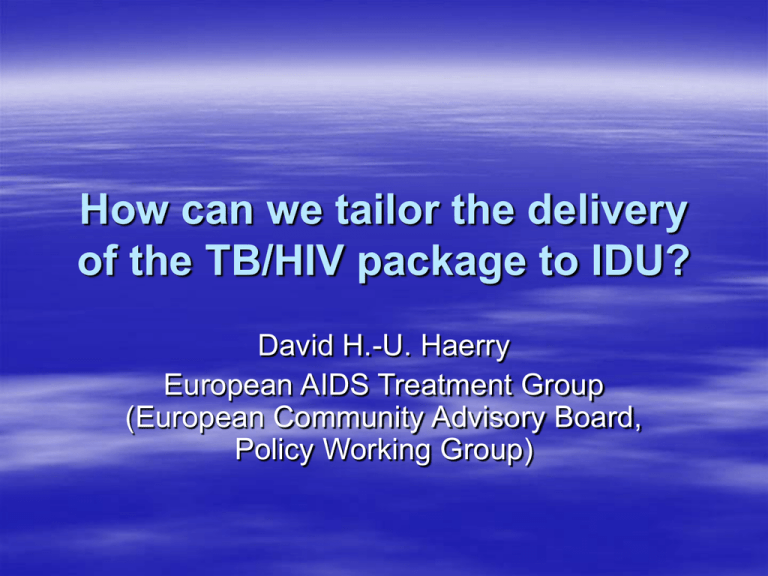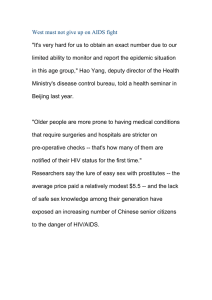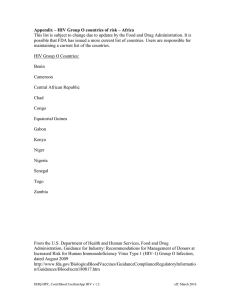How can we tailor the delivery
advertisement

How can we tailor the delivery of the TB/HIV package to IDU? David H.-U. Haerry European AIDS Treatment Group (European Community Advisory Board, Policy Working Group) Eastern Europe & Central Asia 1,4 million HIV infected by end of 2004. 490’000 women, 210’000 new infections & 60’000 deaths in 2004. Ukraine Exponential increase of epidemic since 2000 (+7%) – 2002 (+25%). In 2003, 30% of new infections heterosexual transmission (within IDU subpopulation). 10 – 15% of TB cases in Ukraine MDR. TB leading cause of death among PWAs, 50% of AIDS-related deaths are due to TB. 45’000 patients in need of ARV, 1500 treated (GFATM component). Russia 70% of all HIV infections registered in Eastern Europe/Central Asia. Estimated 860’000 PWHAs in Russia, 80% aged 15 – 29, >1/3 women (Dec. 2003). 1.5 – 3 million Russian IDUs (1 – 2% of population), 30 – 40% use non sterile syringes. In 2004, 80% of reported HIV cases among IDU. 70% sexually active. Sharp increase of pregnant women with HIV. Latvia, Estonia, Lithuania Latvia: 5-fold increase 1999 – 2002 (2300). Estonia: 1999 12 new cases, 2003: 840. Lithuania: 2001 72 new cases, 2002 increase more than 5-fold. Infections mostly due to injecting drug use, sexual transmission is gaining ground. Eastern Europe / Central Asia 90% of HIV cases caused by injecting drug use. <1% of HIV-positive IDUs have access to ARV treatment (or medical care in general). TB patients are 10 times more likely to have MDR-TB than in the rest of the world. Estonia, Kazakhstan, Latvia, Lithuania, Russia and Uzbekistan: MDR up to 14%. 79% of MDR-TB cases are "super strains", resistant to at least three of the four main drugs used to cure TB. Kaliningrad: highest documented HIV prevalence within Russia. 70 – 80% of HIV-infected IDUs have had hepatitis C exposure. Treatment access in the region 11% of patients in need of ARV are getting treatment. Due to legal restrictions & discrimination, HIV-positive IDUs have limited or no access to treatment. Problems we are facing Conflict healthcare priorities - current drug policy. Double-stigma in society. Discrimination in medical institutions. Fear of police harassment. Unwillingness of medical infrastructure to meet the demands of this patient group. Main barriers for equal access to HAART No political commitment to meet the requirements of the epidemic. Repressive drug policies supersede the principles of public health. High prices for ARV and diagnostic equipment. No national protocols on HIV treatment and care that meet international standards focusing IDU patients. Vertical and centralised AIDS-service infrastructure. Illegal substitution treatment programmes (Russia). Limited number of ST programmes. Limited NGO involvement into HIV care and treatment. Stigma and discrimination within medical institutions. Ukraine – assessment on TB treatment in IDUs Artur Ovsepyan, All-Ukrainian Network of PWHAs, 2005 AIDS-centres, TB hospitals and drug-addiction clinics in 13 regions of Ukraine. 40 medical institutions assessed. 14 have access to opiate analgetics. 13 have license for storage and prescription of opiate medications, 2 are planning to obtain license. 2 medical institutions prescribe buprenorphine for ST – Kherson and Odessa drug addiction clinics. 16 patients received ST with buprenorphine in 2004. 2540 patients have interrupted TB treatment because of drugaddiction (expelled from hospital because of drug-use). 420 TB patients with HIV co-infection that have interrupted TB treatment because of drug-use. Conclusions (based on assessment) TB and AIDS-service infrastructure are desintegrated and parallel in Ukraine. TB and HIV services do not have legal or administrative authority to ensure access to opiates as part of palliative care and ST. Clear evidence: most IDU patients cannot receive appropriate TB care without access to ST. Urgent need to overcome these barriers a) to provide required medical care for IDUs b) to overcome of TB/HIV epidemic. Brazil São Paolo: epicenter of injection-driven epidemic, 50% of all HIV cases in Brazil. Assessment has shown that 69% of all people on treatment successfully followed treatment procedures. Decentralized and widely available “user-friendly” network of clinics (up to 300 day clinics across the country). Development of a harm reduction strategy on national scale. Effective integration of harm reduction projects in care programs (incl. hepatitis vaccination etc). Creation of a national drug-user organisation with strong support of health professionals and local authorities. Key factor of Brazilian success Government commitment to provide universal and equal access to treatment as part of the overall strategy to fight HIV in the country. Recommendation: Need of a comprehensive care programme, including TB treatment & prevention – isoniacid? Hepatitis treatment & prevention. HIV/AIDS treatment & prevention. Effective harm reduction & substitution programmes, including prison settings. Access to safe conception methods. Requirements Support community-based advocacy, education and mobilisation. Promote international care standards for HIV-TB-Hepatitis co-infection. Promote reference centres for integrated HIV-TB-Hepatitis care. Promote substitution programmes as integrated part of the TB/HIV service kit for IDUs (one stop shopping model). Perform ARV/TB/hepatitis drugs – street drug interaction studies. Coordinate ARV-TB-hepatitis drug provision at affordable prices; plan first-, second-line and salvage regimens. Invest in training: health care professionals & patient organisations. Conclusions IDUs must be identified as a special category of patients with specific needs. Interaction studies in ARV/TB/Hepatitis treatment – street drug must be performed. ST access in TB / HIV medical services is a cornerstone of effective HAART and TB treatment for IDUs and a vital factor for overcoming the TB/HIV epidemic in the CIS region.


